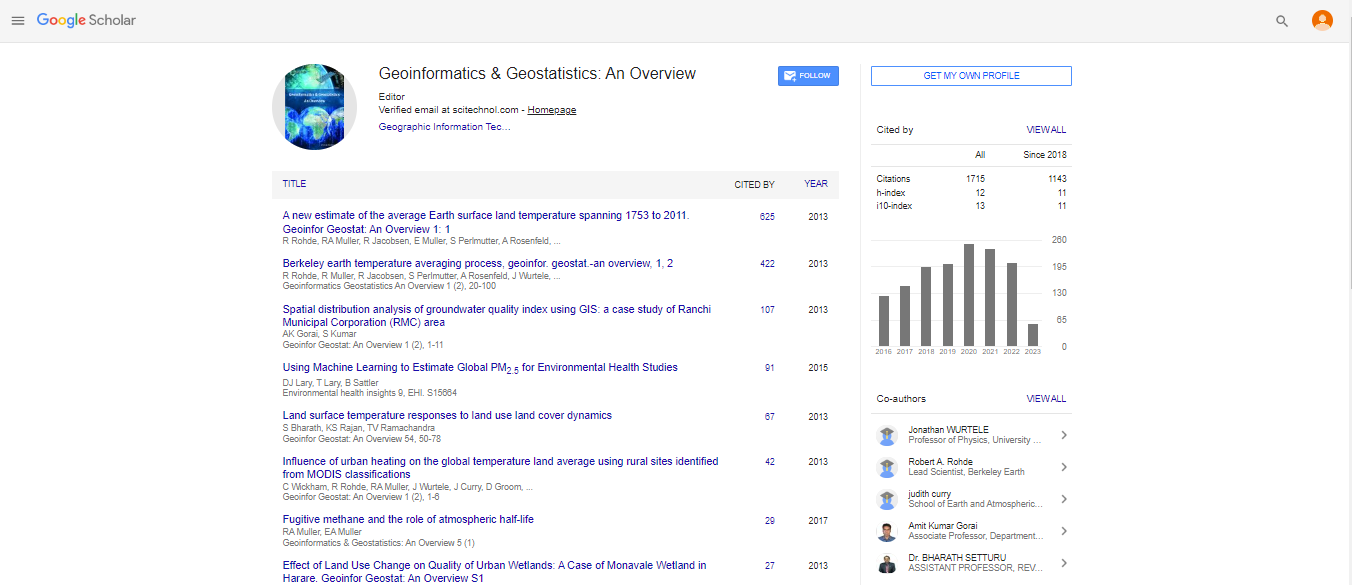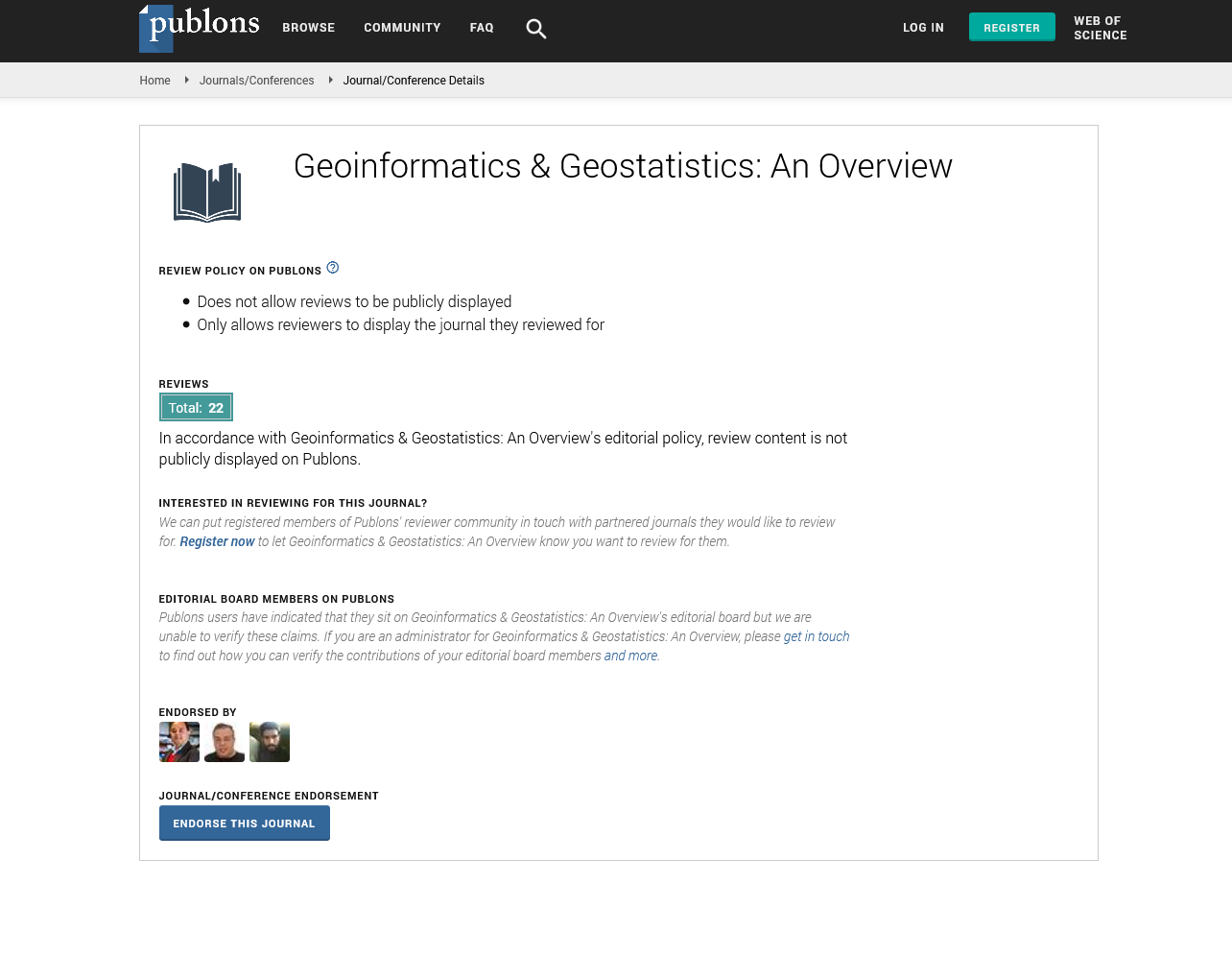Opinion Article, Geoinfor Geostat An Overview Vol: 12 Issue: 5
Mapping and Modeling Urban Heat Islands Using Remote Sensing and Geostatistics
Fletcher J Leo*
1Department of Spatial Analysis, University of Edinburgh, Edinburgh, Scotland
*Corresponding Author: Fletcher J Leo,
Department of Spatial Analysis,
University of Edinburgh, Edinburgh, Scotland
E-mail: fjleo78532@edu.ac
Received date: 23 September, 2024, Manuscript No. GIGS-24-150364;
Editor assigned date: 25 September, 2024, PreQC No. GIGS-24-150364 (PQ);
Reviewed date: 09 October, 2024, QC No. GIGS-24-150364;
Revised date: 16 October, 2024, Manuscript No. GIGS-24-150364 (R);
Published date: 23 October, 2024, DOI: 10 .4172/2327-4581.1000418.
Citation: Leo FJ (2024) Mapping and Modeling Urban Heat Islands Using Remote Sensing and Geostatistics. Geoinfor Geostat: An Overview 12:5.
Description
Urban Heat Islands (UHIs) represent a significant environmental challenge in contemporary cities, where built environments and human activities contribute to elevated temperatures compared to surrounding rural areas. The phenomenon arises from factors such as the concentration of buildings, roads and other infrastructure that absorb and retain heat. Understanding and reducing UHIs is important for enhancing urban resilience, improving public health and promoting sustainable urban development. This essay explains the application of satellite data and geostatistical analysis in studying UHIs and how these methodologies can inform effective reducing strategies.
Urban heat islands occur when urban areas experience higher temperatures than their rural counterparts. This temperature differential can be attributed to several factors, includes. Concrete and asphalt have high thermal conductivity, absorbing more solar radiation than natural landscapes. Urban areas often have fewer trees and green spaces, which play a critical role in cooling through shading and evapotranspiration. Increased energy use from transportation and industrial activities generates additional heat. High-rise buildings can create canyons that trap heat and reduce airflow.
The implications of UHIs are intense, contributing to increased energy consumption, air pollution and heat-related health issues. Consequently, addressing UHIs is vital for urban planning and public health. Satellite remote sensing offers a powerful tool for monitoring and analyzing urban heat islands. Sensors on satellites can capture thermal infrared data, providing surface temperature readings across extensive urban areas. The advantages of using satellite data include.
Satellites can capture data over large geographic areas, allowing for comprehensive assessments of UHI extents and variations. Repeated satellite observations enable researchers to analyze changes in UHI intensity over time, correlating them with urban development patterns and climate change. Advanced satellites can provide high-resolution images, allowing for detailed analysis of urban microclimates.
Data from satellites like Landsat, MODIS (Moderate Resolution Imaging Spectroradiometer) and Sentinel-2 have been pivotal in assessing UHI characteristics. For example, researchers can use MODIS data to derive Land Surface Temperatures (LST), which can then be correlated with land use data to identify hot spots and assess the effectiveness of existing vegetation cover. Once satellite data is acquired, geostatistical analysis provides robust methodologies for interpreting the spatial patterns of UHIs. Techniques such as kriging, interpolation and spatial autocorrelation are essential for understanding how temperature variations relate to urban features. This geostatistical technique estimates the value of a variable at unmeasured locations based on values from nearby sampled locations. In UHI studies, kriging can be used to generate continuous temperature surfaces that reveal localized heat patterns.
Analyzing the degree to which temperature readings correlate across space can identify clusters of high or low temperatures. This analysis helps to understand how urban design and vegetation influence UHI patterns. Identifying areas with significantly higher temperatures allows urban planners to target specific regions for mitigation strategies, such as increasing greenery or improving reflective surfaces. The insights gained from satellite data and geostatistical analysis can inform various reducing strategies to combat UHIs.
Increasing urban greenery through parks, green roofs and tree canopies can significantly reduce surface temperatures. Geospatial analyses can help identify areas where vegetation can have the most substantial cooling impact. Implementing reflective materials for roofs and pavements can lower surface temperatures. Satellite monitoring can assess the effectiveness of these interventions over time. Datadriven insights can guide urban planning policies that prioritize green spaces and sustainable building practices. By integrating UHI data into zoning and land-use planning, cities can enhance adaptability against heat extremes. Informing local communities about UHI effects and mitigation options can foster grassroots initiatives for increasing urban greenery and heat-reducing interventions.
Conclusion
The study of urban heat islands using satellite data and geostatistical analysis presents a comprehensive approach to understanding and minimizing the effects of urban heat. By utilising advanced remote sensing technologies and spatial analysis techniques, cities can better identify UHI patterns and develop targeted strategies to enhance urban adaptation. As urbanization continues to accelerate, integrating these methodologies into urban planning and policy-making will be essential for promoting sustainable, livable cities. Addressing UHIs not only improves urban climates but also contributes to public health, energy efficiency and overall quality of life in urban environments.
 Spanish
Spanish  Chinese
Chinese  Russian
Russian  German
German  French
French  Japanese
Japanese  Portuguese
Portuguese  Hindi
Hindi 
